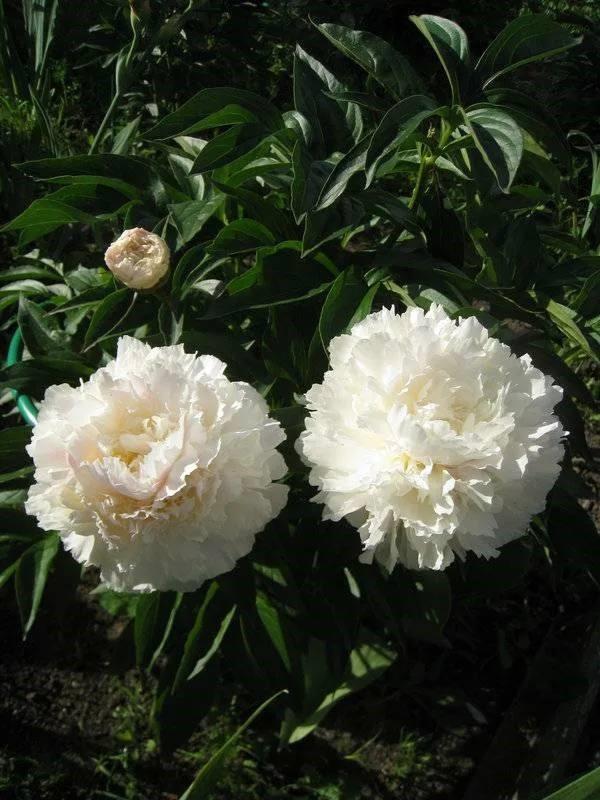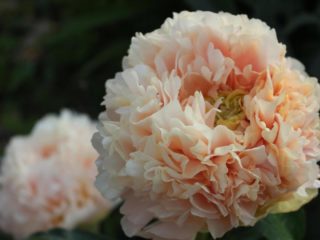Content
Few people know that until the mid-20th century, all peonies in the CIS countries came from France. They were grown in dachas, decorated with them in parks, squares, and other areas, but they did not know the names of the varieties of these amazing flowers. French peonies have a huge number of varieties. You can get acquainted with their features, agricultural technology rules, and reviews from flower growers in this article.
Features of French peonies

Ancient varieties of French selection demonstrate an amazing combination of different colors: from delicate pastels to bright colors
At the beginning of the 20th century, peonies were brought to Russia from France. They were grown in botanical gardens and used as medicinal plants. Then peonies began to be planted in manorial estates. After the revolution, flowers from dispossessed noble estates scattered into rural gardens.Residents of the countries of the former USSR had an impression of peonies thanks to French varieties.
According to the ideas of people from the CIS countries, the flower should emit a wonderful aroma. Otherwise, it is not a peony at all. All ancient classic varieties bred by French breeders are distinguished by a strong aroma of lilies of the valley, roses, lilacs, jasmine or citrus fruits. All of them bloom with lush double inflorescences of pink, crown, spherical or hemispherical shape.

The shape of flowers of ancient species is their main feature; it can be similar to a rose, camellia or a classic peony with a large number of petals
The best varieties of peonies of French selection
Varieties of old peonies native to France come in a variety of colors. They also differ in the characteristics of buds and bushes. It is worth looking at photos of white and other peonies of ancient French varieties to get a complete picture of them.
Duchesse de Nemours
The Duchess of Nemurs variety was developed in 1856. The French peony is characterized by large white outer petals that surround a spherical light yellow center. The shade turns to pale green at the center.

During the flowering period, the light yellow core turns pale and becomes almost white
This gives the effect of a pure snow-white flower. The plant emits a delightful subtle smell. The bush grows tall, the stems are strong, the leaves are smooth and rich green.
Marie Lemoine
The chic French look in white Marie Lemoine was created in 1869. This is a late flowering variety.

Marie Lemoine flowers are densely double, very large, and emit a strong aroma of roses
When the peony begins to bloom, the bud is compact and slightly flat. The petals are lemon-white with a crimson edge.Afterwards, the bud takes on a large spherical shape with a lemon tint in the middle. Thanks to its snow-white petals, the French peony looks like a cloud. The bushes are low, the stems are powerful, and can safely support huge spherical inflorescences.
Amabilis
The Amabilis variety was developed in 1856. The name translates as “dear”, “gracious”. This is a popular French species grown in gardeners' gardens these days. The flowers are double, bright crimson, with pale pink petals in the center. The variety is considered one of the most non-capricious and easy to grow. The flowering period is mid-early, the buds bloom alternately.

Lushly blooming Amabilis peony bushes emit a sweet aroma
Queen Hortensia (Reine Hortense)
The mid-early French species appeared in 1857. The variety is characterized by large double flowers. The petals are soft pink, fluffy, with a translucent texture. Their ends are corrugated, silvered, with crimson splashes in the middle. The bush is tall, blooms profusely, with powerful stems and emerald foliage.

The aroma is characteristic of peonies, strong, not cloyingly sweet.
Mai Fleuri
The ancient peony bush Me Fleury became famous in 1905.

The flower is peach-pink-cream, very large in size.
In the center there are multiple yellow stamens and crimson stigmas. The bush grows tall, with a spectacular voluminous foliage mass. The leaves are bronze-brown, which is unusual for peonies.
Avalanche
A mid-late milky-flowering variety of French selection, Avalanche, was bred in 1886.

Terry petals, white with a pale pinkish center
They have reddish marks. The foliage is dark green, the stems are strong and tall.The flowers smell unobtrusively, reminiscent of the smell of a rose. The bush grows compact, the leaves are pointed-ovate.
La Lorraine
The French variety La Lorraine became famous in 1901. Tall bushes bloom with large cream flowers with a pink center. The period of bud opening is mid-late.

Herbaceous peony produces a faint sweet aroma
Le Cygne
The famous Lemoine variety of peony bushes, Le Xin, was bred in 1907. The petals are white with a yellowish tint. The deciduous mass is emerald, with a smooth surface.

Le Xin bushes are tall, the buds emit a faint aroma
Edulis Superba
The ancient variety Edulis Superba was bred in 1824. The outer petals are pink-lilac, the inner ones are narrower and lighter. As the buds age, they take on a crown shape.

Edulis Superba bush of medium height, bending and spreading stems
Peony produces a strong aroma characteristic of the culture.
Madame Claude Tain
The variety of French selection of terry peonies Madame Claude Tain appeared in 1927. The herbaceous plant produces white, pink-shaped flowers with a slight creamy glow in the middle. Inflorescences form on each stem. The foliage is dark green, the stems are strong, brownish-green.

The bushes of Madame Claude Tain grow to medium height, the buds emit a pleasant aroma
Monsieur Jules Elie
The ancient variety Monsieur Jules Ely was bred by breeders in 1888. The herbaceous peony is found in gardens around the world.

The Monsieur Jules Ely flower is huge, spherical, with large outer petals
They have a lilac-pink hue with a silvery sheen that fades to almost white. The stems are strong, thick, and firmly hold large inflorescences. The bush grows tall and spreading.
Solange
The fantastic variety of peonies of the French selection Solange appeared thanks to the work of flower growers in 1907.

Solange blooms late, flowers bloom alternately
The petals combine white, pink, cream and silver shades. The bushes grow to medium height. The leaves are emerald with a smooth surface, the stems are strong.
Festiva Maxima
One of the popular ancient varieties, Festiva Maxima, was bred in 1851.

The flowers are formed large, densely double, pink-shaped with a reddish border in the center
Snow-white petals harmoniously fade against the background of emerald foliage. The bushes grow tall, the stems securely hold large buds. They emit a delicate, unobtrusive aroma.
Primavere
Primavere is a variety of anemoid peony that became known in 1907. The outer petals are creamy white, cupped, and rarely pinkish. The center consists of short narrow petals of a soft yellow hue. Over time, the center fades to a pure white color.

Primavere bushes grow tall and bloom profusely
The leaves are dark green, the stems are very weak and need support. The plant emits a faint aroma, characteristic of peonies.
French peonies in landscape design
French varieties of peonies are widely used in site decoration, creating flower arrangements, rockeries, and alpine slides with them. Enchanting bushes also look stunning as part of a single flower bed. Peonies are dominant plants, but it is recommended to adhere to certain rules when using them in landscape design:
- A French flower growing alone will look strange next to a large tree. It is better to plant low-growing shrubs nearby, for example, roses, phlox, lilies, and irises.
- Peonies look great in designs with contrast. To emphasize their beauty, you can plant them near sage, chistema, poppy or sedum. It is worth starting from the color of the petals.
- Lushly blooming peony bushes can grow against the backdrop of a well-groomed lawn. For early species, small-bulb crops such as daffodils or tulips will be an excellent addition.
Guided by ready-made ideas, you can turn even an unattractive summer cottage into a romantic garden.
Conclusion
Antique French peonies come in different varieties, but they are all united by a centuries-old history and amazing decorative qualities. They are easy to care for, the main thing is to follow simple rules of agricultural technology. When using peonies in the decoration of the territory, you need to take into account the optimal proximity and color combinations.
Reviews of French peonies











